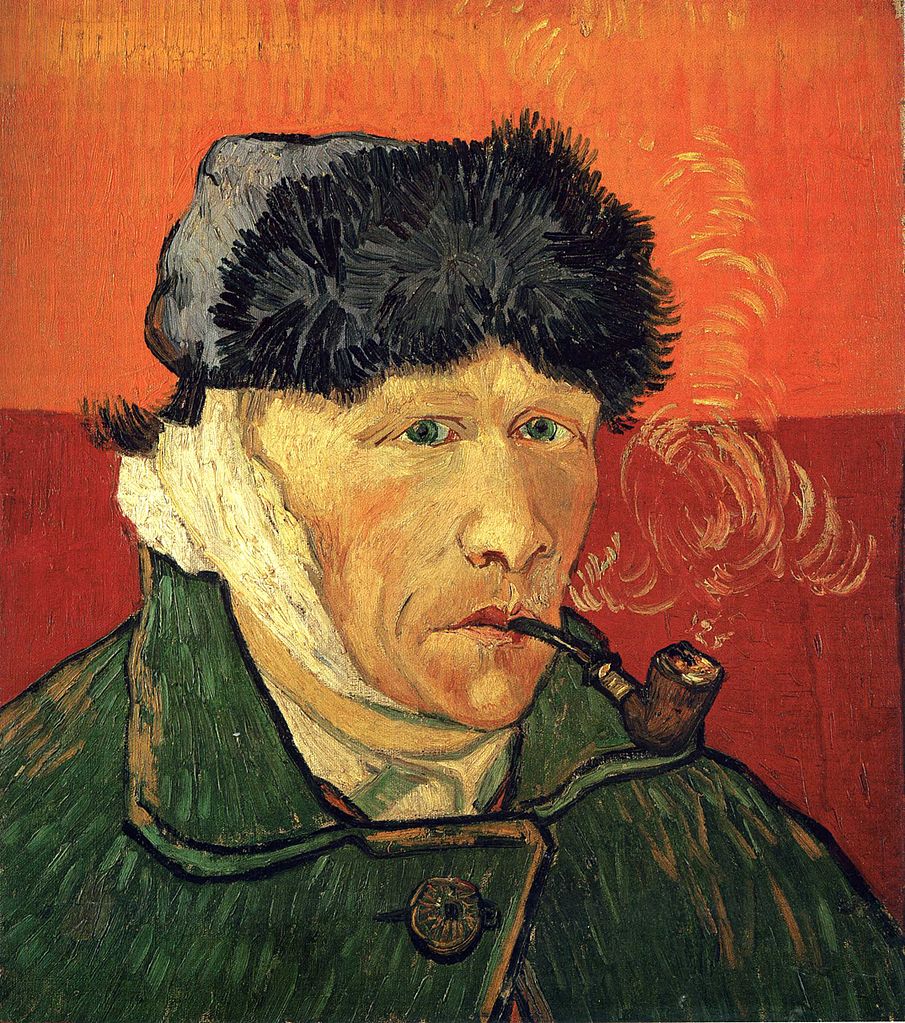Vincent Van Gogh was an admired artist, who was also a troubled and “tortured genius.” His artwork, Starry Night, Bedroom in Arles, and many others have earned him fame and recognition as one of the greatest artists of his time. But what many remember most about this artist is the story of his severed ear. Although his art is exemplary, his struggle with mental health and self-harm is admirable. His struggle was overlooked due to his incredible talent. He was successful as an art dealer, but as an artist, he had to prove himself with the headquarters of international art dealers, Gopil & Cie. During his lifetime, Van Gogh was the poster boy for the image of starving artist. His artwork was not recognized until much later in his career, which could have been a leading cause of his major depression and anxiety.1
Van Gogh, born in the Netherlands, decided to start his career in Paris in the 1880s, where many of the age’s great artists also resided. He believed he could get recognition for his pieces through his younger brother, Theo, who made his living as an art dealer. His brother introduced him to many artists, including Georges Seaurat, Camille Pisatto, and Paul Gauguin. Upon meeting these successful artists, Van Gogh was greatly inspired by their work and began creating his own artistic style, beginning in 1883. Later the same year, Van Gogh rented a small house in Arles, in the south of France. Paul Gauguin and Van Gogh became close friends and later roommates. They consistently bounced ideas off of each other and created a strong friendship.2

Like many friendships, theirs was rocky, and they found themselves drifting apart. Gauguin had moved on to a different artistic style and was exploring other ideas. Van Gogh at the time, had been reciprocating signs of depression and mental health issues, but at the time, these symptoms were considered normal. When Gauguin decided to explore other art spectrums, it involved moving out of the house he and Van Gogh shared. He broke the news to his roommate about his intentions, and this evidently this made Van Gogh go over the edge. He did not take the news lightly and both men began verbally arguing. Van Gogh had disappeared for a few hours and when he returned to confront Gauguin, he had a razor blade in hand threatening to hurt Gauguin.3
During the confrontation, however, Van Gogh was hesitant to hurt his friend and decided to turn the blade on himself and completely cut off his ear. Gauguin left him bleeding and alone. Van Gogh bandaged his head and began drowning himself in alcohol. During this episode, he walked out of his home and into the streets where he found a prostitute. The ear that he had severed off of himself had been neatly wrapped in a cloth; since Van Gogh was still heavily intoxicated, he decided to present this token to the prostitute. Patiently, she ran off and alerted the police about her encounter and they immediately rushed to his home.4
Shortly before Christmas Eve, Van Gogh was found by police in his bed, partially conscious and with major blood loss. Authorities rushed him to the hospital where he surprisingly recovered. Meanwhile, Gauguin was brought into questioning, but gave no testimony on the incident. It was believed that Van Gogh had suffered a severe mental breakdown long before he had severed his ear, but that this created a ripple effect that led to lunacy. The real reason behind the infamous Van Gogh ear-cutting may never be known; Gauguin had promised Van Gogh a pact of silence on the situation in letters that they supposedly exchanged. 5

After the incident, Van Gogh was admitted into a psychiatric facility in hopes of recovering mentally and physically. The dramatic change was not helpful for such a troubled artist, and in July of 1890, Vincent Van Gogh ended his life with a revolver. Before his suicide, however, he created a very iconic painting, Self Portrait with Bandaged Ear 1889. Van Gogh intended to persuade his doctors that he was perfectly able to continue working and creating art by creating this self portrait. He presented his piece, leaving a trail of wonder for his supporters as to why he included certain details in this particular piece, mainly because he continued to paint himself in the same yellow house he and Gauguin shared. Doctors overlooked these details and allowed Van Gogh to leave the facility.6
The epidemy of many artists like Van Gogh is often associated with mental instability, drug use, and alcohol abuse. Van Gogh had an array of medical issues that were tied back to his coping mechanisms (alcohol abuse), and as a result, many did not understand the struggles he faced and degraded him as a person while idolizing his artistic talent. As said before, the real reason behind his mutilated ear will be unclear, but his work and talent will continue to inspire and educate.
- Adam Gopnik, “Van Gogh’s Ear,” The New Yorker, Literature Resource Center (January 4, 2010): 48. ↵
- “Who Really Cut Off Van Gogh’s Ear?” Weekend All Things Considered, Literature Resource Center, (May 2010). ↵
- “Who Really Cut Off Van Gogh’s Ear?” Weekend All Things Considered, Literature Resource Center, (May 2010). ↵
- Belinda Thomson, “Comparing lives: issues of balance in biographical writing,” Literature Resource Center, French Politics, Culture and Society 24, no. 2 (2006): 60. ↵
- Tim Suermondt, “All the Answers.” Literature Resource Ceter, Prairie Schooner 85, no.3 (2011): 47. ↵
- Tim Suermondt, “All the Answers,” Literature Resource Center, Prairie Schooner 85, no. 3 (2011): 47. ↵



170 comments
Carlos Vazquez
Vincent Van Gough is one of the world’s most iconic painters. His work of art is now one of the most renown and famous pieces today. It is sad that he never really got to see his work become famous, and that he suffered with mental illness his whole life. This article is very well written and informative, I really enjoyed reading about Van Gough.
Destiny Renteria
It is was good to bring attention to this because it is great to know the issues that go on with very famous people, and not everything is what it seems. His paintings were amazing and it is good to know that there is a background to a very well known artist. I appreciate his art and I am glad I can interpret his art to anything that I feel. I really enjoy this article and again was very well written! Hopefully this does bring awareness to mental illness with anyone in general because you never know what someone will be going through. It can be shown in many things and this just so happened to be in his art.
Kailan Pena
I personally love Van Gogh and his masterpieces so I figured this article was a must-read, and I can say sincerely after reading this that indeed it is. I’ve heard so many versions of Van Gogh’s severed ear story but this one seems to be the most credible with sufficient sources to support the story. I had no idea that he got in an altercation with a roommate that led up to the severing, and I had no idea he tried to give his ear to a prostitute, that’s truly crazy.
Alyssa Childs
It’s very tragic that such a unique and excellent artist would take his life. Was depression not taken seriously back then? I have read many stories on Van Gogh and in every story it ends sadly. It’s strange to me how people could just hurt themselves and/or others. Many believe that he cut his ear of just to become, eventually, famous for that. If it wasn’t for that prostitute he would of probably died. Van Gogh’s pieces were odd but very unique in my opinion. Typically, artist use their problems to create art and majority of the time the piece comes out brilliantly. Van Gogh had a very interesting life and I bet were all just amazed about how creative he was and mourning the loss of a brilliant artist.
Anais Del Rio
Before reading the article, I never knew that Van Gogh was roommates with Paul Gauguin as well as him presenting his cut off ear to a prostitute rather than a girlfriend. After knowing that he suffered from mental illness, I believe that he used art as an outlet to his feelings and attempt to not go completely crazy or to make it seem like he was okay.
Bryan Martin Patino
i love van gogh as an artist so much, it is true that he struggled so much but i feel that with out that struggle he would have never been the great artist everyone knows him to be now. the man did eat paint which contributed to his disease. van gogh didnt live an easy live and was brushed aside by most of the people that he had met. its still crazy to see that his mental illness never kept him from painting.
Jasmine Jaramillo
Before reading this article I didn’t know much about Vincent Van Gogh. I knew that he is a famous painter and that his paintings are unique. The painting he is known for is Starry Night. Reading this article has given me more information about Van Gogh. I did not know that he suffered from mental illness. I thought the story between Van Gogh and Gauguin was interesting and that cutting his ear must have been very distressful for both people. I think it was amazing that Van Gogh survived even though he lost a lot of blood. It’s sad to hear that such an amazing and influential artist committed suicide but the struggles he dealt with eternally were great and at least he is at peace. Van Gogh’s legacy will live on through his artwork that continues to leave people in awe.
Cristina Cabello
It is crazy how much pain one person can take in. People every day suffer from anxiety or depression. Sometimes it is even the people that seem the happiest. They will bottle up their emotions, because they’ll feel like nobody will understand. Or will want to give them their time to help them. Some might even be scared for help. Maybe through his paintings he was looking for relief.
Isaac Rodriguez
Since I was a child I’ve had an interest in art, but like most people, I knew of the artist Vincent Van Gogh. His “Wheatfield with Crows” is one of my favourite art pieces. While one could assume his mental issues lead him to the removal his ear, I did not know the reasoning behind it, nor did I know that his life ended in suicide.
Tyler Sleeter
Great article. I have always liked the paintings of Van Gogh and think it is terrible that he died not knowing how popular his works would become someday. That Van Gogh suffered some kind of mental illness has never been in doubt but, as you say, we may never know what caused him to cut his ear off or to take his own life later. Mental illness seems to be more prevalent among the artistic community then among the non-artistic community. I have heard that tortured souls produce better artwork, but I am not sure that is believable since many famous painters did not suffer mental illness.